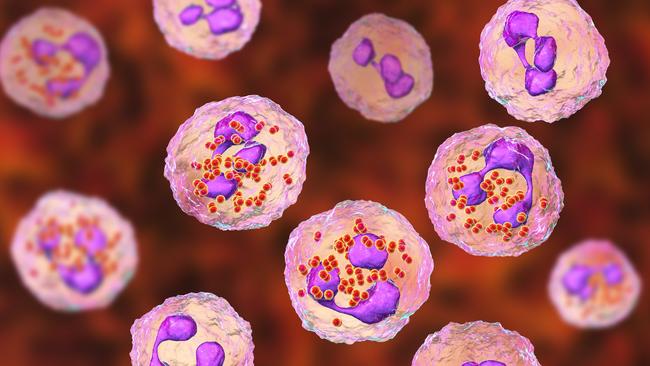‘Return to the dark ages’: Chilling warning as microbes grow more resistant to medicine
A disturbing scientific analysis has concluded that tens of millions of people will die by 2050 as diseases grow ever more resistant to our drugs.
Illness
Don't miss out on the headlines from Illness. Followed categories will be added to My News.
A disturbing worldwide scientific analysis has concluded that tens of millions of people will die by 2050 as diseases grow ever more resistant to our existing drugs.
The study, conducted by the Global Research on Antimicrobial Resistance Project and published by the medical journal The Lancet, highlights the problem implied in its author’s title: diseases are evolving to make the drugs we normally use to combat them less effective.
The problem affects antibiotics, antivirals, antifungals and antiparasitics.
The conclusions are based on data from 204 countries and territories. The researchers estimated the number of deaths that could be blamed on antimicrobial resistance (AMR) from 1990 to 2021, and then forecast how many would occur from now up until 2050.
According to the study, roughly 1.14 million people died because of AMR in 2021. That is expected to rise to 1.91 million annually by the middle of the century.
Expanded to cases in which AMR plays “some role”, the figures from 2021 to 2050 are predicted to go from 4.71 million to 8.2 million.
“Antimicrobial medicines are one of the cornerstones of modern healthcare, and increasing resistance to them is a major cause of for concern,” said the study’s chief author, Dr Mohsen Naghavi.
“These findings highlight that AMR has been a significant global health threat for decades and that this threat is growing.”

AMR will be most damaging in south, southeast and east Asia, Oceania, and sub-Saharan Africa, the study’s authors predict.
Combating the issue will require the development of new forms of antibiotics, widespread vaccination, and various measures designed to lessen the risk of infection.
“Evaluating changing trends in AMR mortality across time and location is necessary to understand how this important global health threat is developing, and prepares us to make informed decisions regarding interventions,” the paper says.
“Our findings show the importance of infection prevention, as shown by the reduction of AMR deaths in those younger than five years.
“Simultaneously, our results underscore the concerning trend of AMR burden among those older than 70 years, alongside a rapidly ageing global community.
“The opposing trends in the burden of AMR deaths between younger and older individuals explains the moderate future increase in number of DALYs (deaths or disability-adjusted life years) versus number of deaths.
“Given the high variability of AMR burden by location and age, it is important that interventions combine infection prevention, vaccination, minimisation of inappropriate antibiotic use in farming and humans, and research into new antibiotics.”
These recommendations come ahead of a meeting on the subject of AMR at the United Nations next week.

There’s a slight Catch-22 at play here. We need to use antibiotics to treat disease, yet the more we do so, the faster bacteria will grow resistant.
“Bacteria and microbes evolve pretty quickly, and anything you throw at them, they’re going to find a way around,” Dr Branwen Morgan, from the CSIRO, told Nine newspapers.
“The more we use antibiotics, the faster we’re going to lose them.”
The site AMR Action and Insights focuses specifically on how AMR affects Australia. It carries a dark warning.
It explains that, once “resistance occurs”, a given drug is “no longer effective at treating infections caused by that particular type of microbe”.
“This can happen when microbes are consistently exposed antimicrobials over a long time, allowing them to evolve and become resistant,” it says.
“The acceleration of AMR is mainly due to the overuse and misuse of antimicrobial drugs in human and animal medicine.
“If we do not slow the rise of antimicrobial resistance, we will return to the dark ages of medicine where surgery becomes inherently risky, and currently treatable infections and injuries kill once again.
“AMR is one of the greatest threats facing humanity.”
The AMR age gap
Age has proven to be a stark dividing line.
AMR deaths have fallen markedly among children under five since 1990, from a high of 488,000 per year to 193,000, and are still trending downwards as access to healthcare and vaccination rises.
However, simultaneously, deaths due to AMR in older age groups are increasing at a worrying rate, particularly among seniors. They’re up 80 per cent since the start date of the study.
“Approximately three-quarters of AMR infections are linked, for example, to hospital infections, and a rapidly ageing population also necessitates more hospital care,” Dr Tomislav Mestrovic, a professor in Croatia, told The Guardian.
“(If) you put in an IV, it gets infected, you get bacteria in the blood, that bacteria is likely to be more resistant.”
Originally published as ‘Return to the dark ages’: Chilling warning as microbes grow more resistant to medicine



